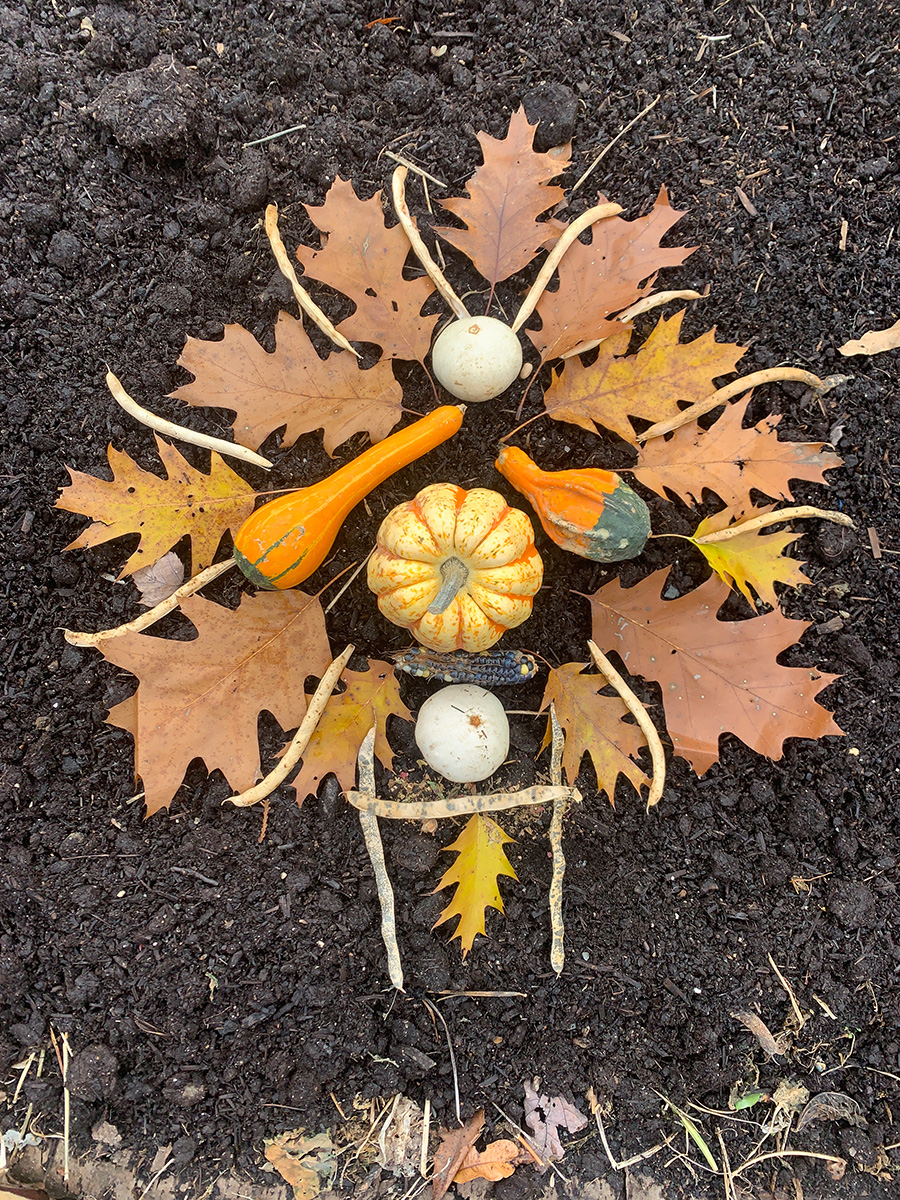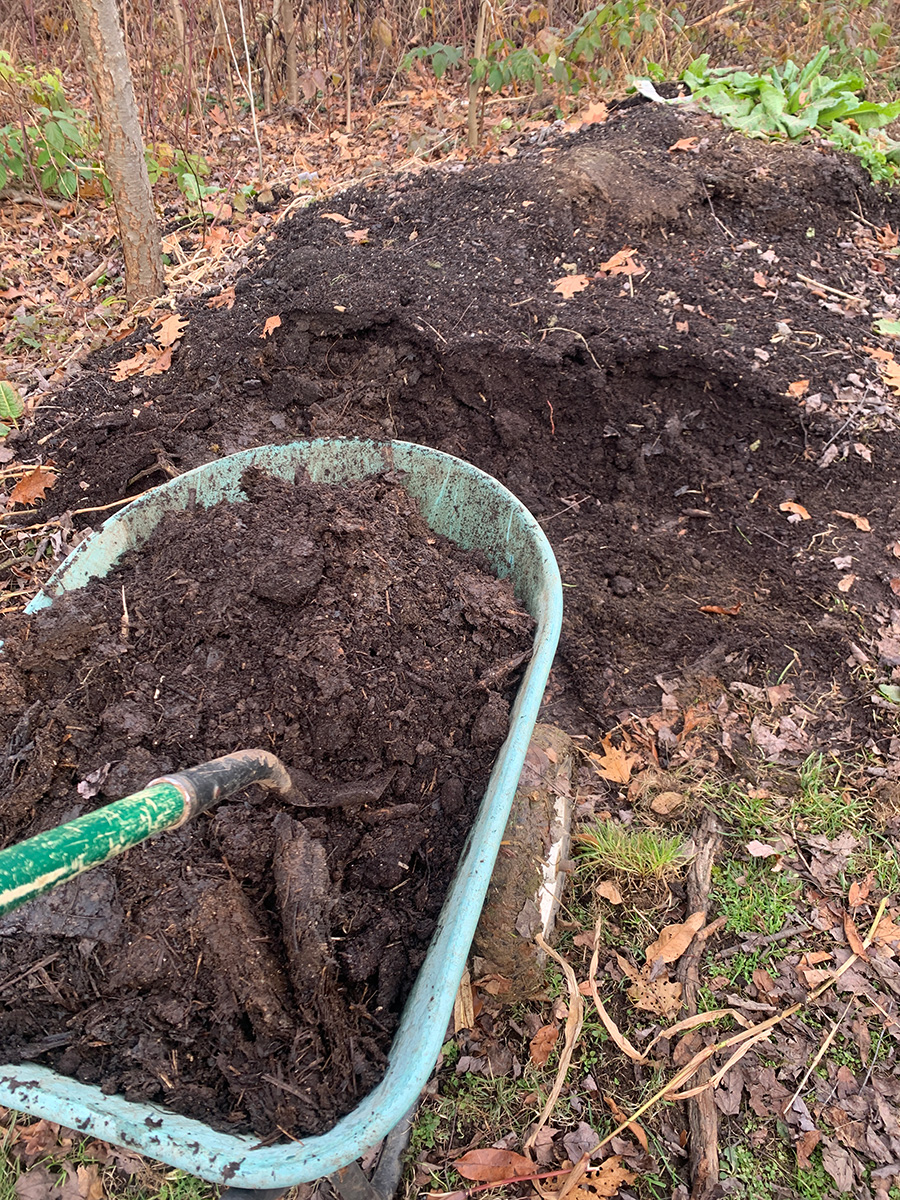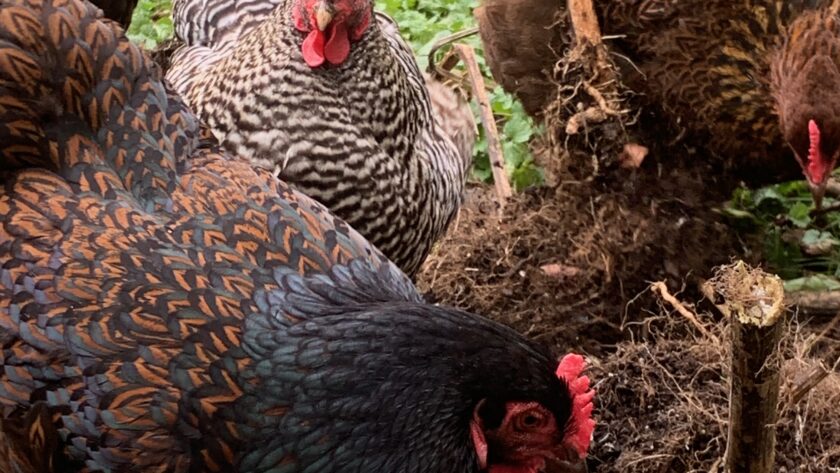The day before the first hard frost. Our garden is still bountiful as the Butzemann watches over all….As the darkness continues to grow deeper on the landscape, it is high time to consider how to put the garden to rest for the winter and honor the garden that has offered you so much bounty and joy for the season. I actually find this one of my favorite gardening activities of the year, both on a metaphysical and physical level. There’s something special about “tucking” your garden in after a productive growing season and knowing that the land will go fallow and rest as the cold and ice come. Here are both the physical activities and sacred activities that you can do to help put your garden to rest.
Do note that my timings are based on the temperate climate in Western Pennsylvania, USDA Zone 6A. You can adapt appropriately based on your own end-of-season and seasonal changes.
Metaphysical Activities
Metaphysical activities support the garden and the downward/restful flow of energy that allows the land to be fallow before returning to abundance in the spring. For millennia, our ancient ancestors all through the world did rituals and ceremonies to support the abundance and health of the land; these are intended in the same direction. (For some you can do later in the year, see this post). Physical and metaphysical activities go hand in hand–everything that we do in the physical world has an impact on the metaphysical, and vice versa. Thus, by working on both levels, we are able to achieve maximum effect.
Burning the Butzemann
In the Pennsylvania Dutch Tradition, the Butzemann is created at Imbolc and set out to protect your crops and land at the Spring Equinox–and we practice this tradition each year. At the Spring Equinox, a friendly guardian spirit is invited into the Butzemann to guard the crops and flocks for the coming season. And at Samhain, the Butzemann must be burned to release the guardian spirit and offer thanks. What we usually do is build a bonfire somewhere near or on Samhain. Then we take our Butzemann to the fire and once again call the Butzemann by name (the naming tradition being very important) and speak of the good things that happened on the homestead and garden (e.g. you protected our crops well, we harvested 15 pumpkins, our flocks were safe from hawks, etc). Then we release the Butzemann to the flames and watch it burn (which is always really cool). This completes the Butzemann ceremony until Imbolc when a new Butzemann is constructed (from the previous garden’s materials and other burnable materials) and the cycle begins again.
Honoring the Soil and Compost through the Soil Web Ceremony

Compost is a major theme this time of year, as so many things die to have their nutrients reclaimed by the soil web of life. Even perennials, including plants and trees, contribute to this great soil web of life. Thus, it is very appropriate to honor the soil web this time of year.
For this, I like to do a “soil web” dance. This is an embodied ritual that involves me dancing (barefoot if possible) on the earth, allowing my footsteps to be my prayer to the earth. I may be moved to praise the soil web, the nematodes, the worms, the bacteria, the protozoa, and so much more. My dance always involves dancing in the garden, through the paths, and eventually to the compost pile. At the compost pile, I leave an offering (last garden harvest food and/or liquid gold are very appropriate here). I may also make symbols with sticks with leaves as a shrine to the soil.
If you created a “last harvest” meal, you can use this as an additional offering (see below).
A “Rest Well” Chanting Ritual for Gardens and Land
Inviting the land into peaceful slumber is another way you can put the garden to bed on a metaphysical level. For this, I particularly like using Ogham and chanting magic (with a drum if it’s warm enough). I chant the following ogham (you can adapt these to your own ecosystem or needs)
- Ruis (Elder) pronounced RWEESH: Elder is for endings, cycles, and resolution.
- Phagos (Beech) pronounced FAH-gus: For preservation, sleep, history, and memory.
- Quert (Apple) pronounced KWEIRT: Apple is for future abundance, blessings, and harvests.
So the chant would go:
Ruis – Ruis – Ruis
Phagos – Phagos – Phagos
Quert – Quert – Quert
And after this, you can start playing with the syllables of each of the three trees in any order, such as:
QUE–eee—iii–rr–tt – QUERT QQQQ —EEERRRR —TTT
And so forth. Just allow your vocal cords and body to explore this expression fully.
End your ritual chant with a focus on Ruis, as Ruis is the Ogham connected to the present moment.
As you chant, really envision the energy of each of these trees coming forth: the Elder coming in to help aid with the end of the season, for closing down, and for resolution. The Beech carries the garden/land through the darkness of winter, where it is able to rest, the soil is preserved, and carries forth the memory of the past into the future. And finally, the Apple, which offers the promise of future abundance and carries a blessing to the garden/land. Really project this energy as you chant. As you feel the ritual is complete, start to wind down, ending with chanting Ruis very softly.
Garlic Ritual: A Land/Sea/Sky blessing

The garlic planting ritual is a really nice way of seeding a blessing for the entire season to come. Garlic is the last thing to be planted in the fall in our ecosystem (at the time you plant garlic, your fall crops should already be being harvested). And that garlic will stay in the ground for almost 9 months, being harvested in the heat of the summer. In the winter, the garlic sets deep roots and then, as the spring comes, it sends its green shoots up into the air.
After you plant your garlic, honor your garlic with a simple land, sea, sky blessing. Gather up the following materials:
- A bowl of hardwood ash (or compost)
- A large bowl or bucket of clean water (rainwater, snowmelt, spring water, water from a local spring or creek) and a bough of a conifer (Eastern hemlock is what I use, but you could also use white pine, cedar, juniper, etc)
- A flute or other woodwind instrument (or your breath)
You can put your items on the ground or create an altar for the ceremony.
Sprinkle the ash/compost on the bed and say, “With the blessing of the earth, may you root deeply this winter. May your roots and bulbs be blessed, and through that blessing, bless this garden in the year to come.”
Next, asperge the bed with water by dipping the branch into the bucket of water and flicking it all over the bed. Say, “With the blessings of the sacred pool, may you be nourished and grow. May your bulbs and roots be blessed, and through that blessing, bless this garden in the year to come.”
Finally, play your flute/woodwind instrument. If you do not have a woodwind instrument, you can get down and blow directly on the soil, offering your breath to the soil. When you are done, say, “With the blessing of the air, may you sprout in the spring and grow strong through the summer. May your entire being be blessed, and through this blessing, bless this garden in the year to come.
Finally, cross your arms and bow your head. Say anything else that comes to mind at this point, honoring your garden. If you created a “last harvest” meal, you can use this as an additional offering for the garlic.
Physical Activities
Physical activities are probably the typical things that people do in the fall–but some of these have a bit of a magical twist. I’ll share the physical counterparts and how these are ritualized and connected to the work above.
Putting the Garden to Rest / Fall bed Prep

Fall bed prep can be any number of things. At the Druid’s Garden homestead, we use sheet mulching/lasagna gardening techniques for our annual vegetable garden areas, and so this is the best time to build soil. After the first hard frost (for us, usually mid-October), we clear away any weedy material and cut back annual plants (leaving the roots in the soil; they will break down and aid in soil compaction).
Then we do some sheet mulching–depending on the bed, this might include a layer of fall leaves and compost, a layer of cardboard (if the weeds got out of control) or simply a layer of finished compost. If we are starting new beds, we always build them in the fall with layers of finished compost, hot compost/straw bedding (from chickens, ducks, geese, and guinea coops), and leaves. You can also consider a winter cover crop (which doubles as fodder for your animals). As you are doing this work physically, you can be doing the metaphysical work I described above. (If you use this method, in the spring, all you need to do is use a broadfork or garden fork to aerate the bed!).
For perennial beds, we will do our final herb harvest of the season, tying up bundles of herbs in the house to dry. We will trim back plants that die back during winter (e.g. echinacea, mountain mint, monarda, etc), and cover up plants that benefit from light cover (strawberries). We will also harvest any extra seeds from our refugia garden so that we can scatter them or give them away in the coming months or year.
Garlic is the one crop that you plant this time of year, and garlic can have its own special ritual, as I described above. I have instructions for planting garlic here.
Once all the summer crops and those that died back after the hard frost are removed, then you can do the “rest well” chant above. Obviously, anything that is still growing (kale, lettuce, etc) is covered and protected for the coming cold, and to extend the harvest season (for more on this approach, see Eliot Coleman’s Winter Harvest Handbook). I like to use these last garden foods through Yule and finish them off for our Yule feast.
Making Compost
Compost making is a great thing to do in the fall, as the winter will allow the compost to break down. At the Druids Garden Homestead, we have chickens to do some of this work for us, but I’ll share a chicken compost and a non-chicken compost method. Our method is to rake up as many fall leaves as we can and place these in a large pile near the coop (of course, jumping and meditating in them is also part of this!). Then, as the snow and ice comes down, we layer another layer of leaves in the chicken run. They don’t like walking on snow and ice, and this keeps them comfortable and occupied. They scratch the leaves up, poop their nitrogen-rich poop, and are happy chickens. When about mid-April rolls around and the ground thaws out, I muck out all of the chicken leaves (along with giving all of the coops a thorough cleaning, which gives us a lot of straw). I layer the chicken leaves/compost with the straw in thin layers, piling this up as high as it will go. You can add anything else here you like (non-weedy) such as coffee grounds and other fresh compost items. With a warm summer, this breaks down into an amazing pile of compost by late fall—just about the time you are doing your garden bed.
If you don’t have chickens, take fall leaves (preferably mulched) and add them in thin layers with other good compost-making things: manure, vegetable scraps, eggshells, coffee grounds, all of the old garden plants that died back during frost (non-weedy) and anything else you have. Keep your layers of leaves pretty thin, especially if you weren’t able to mulch them. Note that some leaves break down really quickly like maple, where others (oak) take a really long time to break down. This approach should get you a nice pile of finished compost by next fall.
For either, honor the compost by doing the Soil Web Dance. You can honor your new piles or your finished piles (or general composting area)
Final Harvest of Summer Crops

The final harvest of summer crops for us comes in the days before the first hard frost. Some things with a light frost can be preserved, but once we hit about 35 degrees, that’s enough to kill of almost all of the summer crops: peppers, nasturtium, tomatoes, basil, pumpkins, squash, beans, zucchini, etc. Thus, starting in early October, we pay very close attention to the nightly temperatures, doing row cover as necessary. But, when our first hard frost is imminent, we harvest the last of the crops: all the green tomatoes that will ripen on the counter for the next few weeks, beans, corn, peppers, basil, etc. We like to cook a special meal with this (Samhain meal if possible, depending on the year) and make a special offering from this for some of the ceremonies above. It is a great way to enjoy the last fruits of the summer season and also create a special offering food.
Gathering for Next Year’s Butzemann
As we are clearing the gardens and the Butzemann, we begin to think about next year’s Butzemann. It is customary to collect some of the materials for use in next year’s Butzemann from this year’s landscape. As we cut the gardens back, we gather materials that are stowed away in our shed till Imbolc. I always like to leave an offering for any plant who is going to be part of the Butzemann. For example, this year, the big patch of Mugwort spoke to me to be included for next year, so I have a large bundle of her saved for next year’s Butzemann.
Conclusion
Late fall is truly one of my favorite times because there is so much richness in how you can engage in sacred gardening and sacred action. I hope that this post has provided you with some ideas for how you might honor your soil, put your garden to rest, and start setting up physically and energetically for the season to come. Blessings!




Reblogged this on Paths I Walk.
I enjoyed this post on putting the garden to sleep, I live in Florida with a nearly year round growing season however for the 25 years that I have lived here I still put my garden to sleep for the winter, my rituals are simple yet I have wanted to do more after reading this post I know I will be adding more this year. After 18 months of illness my garden was all in pots and containers, this year I hope to be well enough to grow my garden in the earth so along with rituals for my garden I think a wellness ritual for myself is in order.
Hi Seasons55, I’m sure you can adapt some of this to Florida–is there a typical time plants die off, etc? I don’t know much about growing in that ecosystem! I’ve always been in places with four seasons. But I think the general principles here could be applied. I’m sorry to hear about your long illness–I hope you can get back on your feet again.
BEAUTIFUL ritual to put the garden to sleep… thanks for your wonderful emails! 🌳🌲🎄🦃🐶🎃🐇🌲🎄
On Sun, Nov 21, 2021, 8:33 AM The Druid’s Garden Dana posted: ” The day before the first hard frost. Our garden is still > bountiful as the Butzemann watches over all….As the darkness continues to > grow deeper on the landscape, it is high time to consider how to put the > garden to rest for the winter and honor the g” >